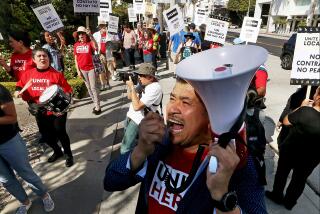Public, private sector wage gap heavily favors many L.A. city workers
For almost a year, the labor groups representing roughly 20,000 Los Angeles city workers have battled at the bargaining table for people like Marshall Turner.
Turner supports his union. Yet when it comes to his job, he’s not complaining. A 59-year-old garbage-truck driver, he made $95,696 last year including overtime. His three decades of city employment enabled him to buy a four-bedroom Rancho Cucamonga home and provide for five children. He recognizes his privileged place in an economy that has grown increasingly bleak for blue-collar workers.
“I feel blessed at the city of Los Angeles,” he said recently over a ramen lunch during a break from collecting trash in South-Central.
That sense of satisfaction is not misplaced — at least not when it comes to his paycheck. Among the city workers who are currently threatening to strike amid contract negotiations that have stalled over pay and other issues, many collect salaries higher than those who do similar jobs in both the public and private sectors, a Los Angeles Times analysis has found.
The analysis, which compared 2014 city and federal wage data, shows that three of the five largest job categories represented by Service Employees International Union Local 721 — the biggest and most prominent of the unions now in contract talks with the city — pay more than double the median salary of similar full-time, private-sector jobs in Los Angeles County.
For example, security guards employed by the city last year made a median base salary of $57,501, compared with $23,330 in the private sector. For city janitors, median annual wages were $46,694, compared with $22,750 in the private sector. City gardeners’ median base salary was $55,173; for those doing similar jobs in the private sector, it was $23,250.
Garbage-truck drivers such as Turner, who make up the largest single job category represented by SEIU, last year made a median base salary of $73,707. Those doing the same job in the private sector made a median salary of $43,200.
The pay disparity can also be seen — albeit to a lesser extent — in comparisons with other government agencies, the data show. The median wage for each L.A. city job class is 18% to 42% higher than that paid public employees doing similar jobs elsewhere in the county, according to the Times’ analysis.
L.A. traffic officers, who are primarily responsible for enforcing parking regulations, made a median salary of $63,626 last year. Median annual pay for parking-enforcement officers at other government agencies was $45,110. (In each job category, half of workers’ salaries are below the median and half above it.)
The analysis used city payroll data for 3,324 SEIU workers, as well as information on L.A. county wages provided by the U.S. Bureau of Labor Statistics. It doesn’t account for all differences in the duties of those working for different public and private employers, nor for differences in workers’ education and experience. It also does not factor in overtime or the value of health and retirement benefits.
The comparison nevertheless underscores a wage gap that has complicated contract negotiations for the Coalition of L.A. City Unions, which represents more than half the city’s civilian workforce. Coalition leaders are fighting demands by city elected officials that workers accept a pay freeze and less generous health and retirement benefits. Union leaders have urged their members to prepare for a strike if the city doesn’t relent.
City employees’ comparatively high pay is partly the result of an across-the-board 24.5% raise the coalition secured during the last round of contract negotiations in 2007. Those raises — which took effect as private-sector workers began seeing their pay stall or slip in the recession — have loomed over the current contract talks and stiffened city officials’ resolve to hold the line on new pay hikes.
Although the 2007 raises were spread out over seven years to soften the hit to the city’s budget, they still came under attack as taxpayers saw basic services, such as library access and street-cleaning, scaled back for lack of funding.
“Ordinary people are paying taxes to pay for those salaries, and ordinary people are losing services because their money is going to pay for those salaries,” said Ed Ring, executive director of the California Policy Center, a fiscally conservative think tank. “It’s not sustainable.”
Alice Goff, president of the American Federation of State, County and Municipal Employees Local 3090 — another group in the labor coalition now in negotiations — said better pay should be a source of pride for city employees. Public-sector work has traditionally served as a gateway to the middle class for L.A.’s poor and minority residents, she said.
“It’s what folks should be striving to, in my opinion,” she said of city workers’ comparatively high pay. “I don’t see why we should go down to meet the others.”
Better wages for city workers also benefit those in the private sector by forcing companies in and around L.A. to increase their pay in order to compete with the city for employees, she said.
Not all accept that premise. Christopher Thornberg, founding partner of the L.A.-based research and consulting firm Beacon Economics, said overly generous public-employee salaries and benefits hurt the local economy by diverting money from public services, such as education, that foster job growth and social mobility.
“There are those who are going to say that this is better for the middle class. Well, it’s not,” said Thornberg, whose firm has been hired in the past to do financial research for city officials. “All the money that’s going to those unions is money that’s not getting invested in our schools. It’s not getting invested in our roads. It’s not getting invested in our infrastructure. It’s not getting invested in social programs.”
The unions now negotiating with the city represent workers in more than 600 different job categories. For some of them, the wage gap with private firms and other government agencies isn’t as pronounced.
Civil engineers and civil engineering associates who work for the city, for example, make a median base salary of $106,050, compared with $88,670 in L.A. county’s private sector and $104,580 at other government agencies.
Guillermo Martinez, a transportation engineer at the city’s harbor department, made $116,985 last year, according to city records. With his bachelor’s degree in electrical engineering from Loyola Marymount University and his California engineer’s license, he said he could probably earn $150,000 if he jumped to a private company. “You don’t come here for the money,” he said. “You come for the benefits.”
Highly skilled workers such as Martinez still exemplify the traditional compact by which government workers accept lower pay for superior healthcare and retirement benefits, said David Lewin, a professor at UCLA’s Anderson School of Management.
Lewin’s research comparing public- and private-sector pay shows that higher wages for low-skill government jobs are offset by lower salaries for public employees with jobs that require more education and training. “I think the argument overall that public-sector employees are overcompensated does not hold up,” Lewin said.
Despite the sometimes heated rhetoric surrounding the current contract talks, some L.A. city workers, echoing Turner, said they felt fortunate.
Sanitation worker Randy Nevels supports the idea of a strike should negotiations with the city remain stalled. But he said he was concerned less about his own job conditions than about supporting SEIU and its broader social and economic agenda.
Having worked for FedEx before the city hired him 14 years ago, Nevels, 52, said he can’t imagine returning to the private sector.
“Things are a lot better on our side,” he said. “You have a lot more job security. I wouldn’t tell anybody anything different. It’s good to work here.”
More to Read
Sign up for Essential California
The most important California stories and recommendations in your inbox every morning.
You may occasionally receive promotional content from the Los Angeles Times.












